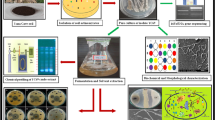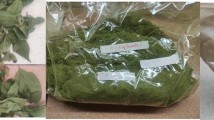Abstract
Two new dihydropyrones, rhytismatones C (1) and D (2), and a known compound, penicillenol A1 (3), were isolated from the co-culture broth of the deep-sea-derived fungus Penicillium crustosum PRB-2 and Suaeda salsa-derived endophytic fungus Penicillium citrinum HDN11-186. Their structures were elucidated through comprehensive analysis of nuclear magnetic resonance (NMR) spectra and mass spectra. The absolute configurations of new compounds were determined by calculating the electronic circular dichroism (ECD) spectrum. UPLC-MS data showed that compounds 1–3 could only be detected in the media of co-culture, suggesting new biosynthetic pathways were activated in the co-cultured fungi. Compound 1 showed obvious antibacterial activities against Proteus sp. MMBC-1002 and Bacillus subtilis MMBC-1004 with minimum inhibitory concentration (MIC) both at 25 µmol L−1.
Similar content being viewed by others
References
Boddy, L., 2000. Interspecific combative interactions between wood-decaying basidiomycetes. FEMS Microbiology Ecology, 31(3): 185–194.
Cho, J. Y., and Kim, M. S., 2012. Induction of antifouling diterpene production by Streptomyces cinnabarinus PK209 in co-culture with marine-derived Alteromonas sp. KNS-16. Bioscience, Biotechnology, and Biochemistry, 76(10): 1849–1854.
Knowles, S. L., Raja, H. A., Roberts, C. D., and Oberlies, N. H., 2022. Fungal-fungal co-culture: A primer for generating chemical diversity. Natural Product Reports, 39(8): 1557–1573.
Knowles, S. L., Raja, H. A., Wright, A. J., Lee, A. M. L., Caesar, L. K., Cech, N. B., et al., 2019. Mapping the fungal battlefield: Using in situ chemistry and deletion mutants to monitor interspecific chemical interactions between fungi. Frontiers in Microbiology, 10: 285.
Li, C., Wang, J., Luo, C., Ding, W., and Cox, D. G., 2014. A new cyclopeptide with antifungal activity from the co-culture broth of two marine mangrove fungi. Natural Product Research, 28(9): 616–621.
McMullin, D. R., Green, B. D., Prince, N. C., Tanney, J. B., and Miller, J. D., 2017. Natural products of Picea endophytes from the Acadian forest. Journal of Natural Products, 80(5): 1475–1483.
Moody, S. C., 2014. Microbial co-culture: Harnessing intermicrobial signaling for the production of novel antimicrobials. Future Microbiology, 9(5): 575–578.
Qu, Q., Yang, F., Zhao, C., and Shi, X., 2019. Analysis of the bacteria community in wild Cordyceps cicadae and its influence on the production of HEA and nucleosides in Cordyceps cicadae. Journal of Applied Microbiology, 127(6): 1759–1767.
Sengoku, T., Wierzejska, J., Takahashi, M., and Yoda, H., 2010. First stereoselective synthesis of Penicillenol A1 via novel O-to C-acyl rearrangement of O-acyltetramic acid. Synlett, 2010(19): 2944–2946.
Watanabe, T., Izaki, K., and Takahashi, H., 1982. New polyenic antibiotics active against gram-positive and -negative bacteria. I. Isolation and purification of antibiotics produced by Gluconobacter sp. W-315. Journal of Antibiotics, 35(9): 1141–1147.
Wu, G., Ma, H., Zhu, T., Li, J., Gu, Q., and Li, D., 2012. Penilactones A and B, two novel polyketides from Antarctic deep-sea derived fungus Penicillium crustosum PRB-2. Tetrahedron, 68: 9745–9749.
Wu, G., Qian, X., Huang, Y., Liu, Y., Zhou, L., Wang, W., et al., 2022. Nonenzymatic self-assembly access to diverse ortho-quinone methide-based pseudonatural products. Organic Letters, 24(28): 5235–5239.
Yu, G., Sun, P., Aierken, R., Sun, C., Zhang, Z., Che, Q., et al., 2022. Linear polyketides produced by co-culture of Penicillium crustosum and Penicillium fellutanum. Marine Life Science & Technology, 4(2): 237–244.
Yu, G., Sun, Z., Peng, J., Zhu, M., Che, Q., Zhang, G., et al., 2019. Secondary metabolites produced by combined culture of Penicillium crustosum and a Xylaria sp. Journal of Natural Products, 82(7): 2013–2017.
Yu, G., Wu, G., Sun, Z., Zhang, X., Che, Q., Gu, Q., et al., 2018. Cytotoxic tetrahydroxanthone dimers from the mangrove-associated fungus Aspergillus versicolor HDN1009. Marine Drugs, 16(9): 335.
Yu, G., Zhou, G., Zhu, M., Wang, W., Zhu, T., Gu, Q., et al., 2016. Neosartoryadins A and B, fumiquinazoline alkaloids from a mangrove-derived fungus Neosartorya udagawae HDN13313. Organic Letters, 18(2): 244–247.
Acknowledgements
This work was supported by the National Natural Science Foundation of China (No. 41806167), the High-Level Talents Research Fund of Qingdao Agricultural University (No. 665/1120034), the NSFC-Shandong Joint Fund (No. U1906212), the Major Project of the 14th Five-Year Plan (No. 2022QNLM030003-1), the Natural Science Foundation of Shandong Province (No. ZR2021ZD28), the Hainan Provincial Joint Project of Sanya Yazhou Bay Science and Technology City (No. 2021CXLH0012), and the Youth Innovation Plan of Shandong Province (No. 2019KJM004).
Author information
Authors and Affiliations
Corresponding author
Rights and permissions
About this article
Cite this article
Yu, G., Zhou, L., Wu, G. et al. New Antibacterial Dihydropyrones Induced by Co-Culture of Penicillium crustosum PRB-2 and Penicillium citrinum HDN11-186. J. Ocean Univ. China 23, 216–220 (2024). https://doi.org/10.1007/s11802-023-5676-4
Received:
Revised:
Accepted:
Published:
Issue Date:
DOI: https://doi.org/10.1007/s11802-023-5676-4




